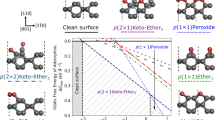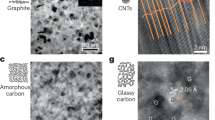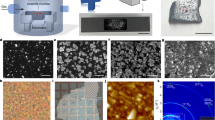Abstract
THE growth of diamond thin films by low-pressure vapour deposi-tion should find technological applications in such diverse fields as hard coatings for cutting tools, lens coatings, heat sinks and electronics1–4. Under such growth conditions diamond should be unstable relative to graphite, yet diamond is formed in practice. Present approaches to describing the growth of diamond explain this paradox by means of a variety of surface kinetic reactions that are controlled by concentrations of adsorbed hydrogen and hydrocarbon radicals5–8. Here we propose a simpler explanation, that high vacancy concentrations are present near the growth face of the diamond film. The formation energy of vacancies in diamond is lower than in graphite, so that large vacancy concentrations (1–8%) can raise the formation energy of graphite above diamond, permitting nucleation and stable growth of diamond. This quasi-thermodynamic model is fundamentally different from the kinetic models for diamond film growth, and predicts that the growth of films with low defect concentrations will be difficult.
This is a preview of subscription content, access via your institution
Access options
Subscribe to this journal
Receive 51 print issues and online access
$199.00 per year
only $3.90 per issue
Buy this article
- Purchase on SpringerLink
- Instant access to full article PDF
Prices may be subject to local taxes which are calculated during checkout
Similar content being viewed by others
References
De Vries, R. C. A. Rev. Mater. Sci. 17, 161–187 (1987).
Angus, J. C. & Hayman, C. C. Science 241, 913–921 (1988).
Diamond and Diamond-Like Material Synthesis (eds Johnson, G. H., Badzian, A. R. & Geis, M. W.) Extended Abstracts. E4-15 (Materials Research Society, Pittsburgh, 1988).
1st Int. Symp. Diamond and Diamond-like Films (eds Dismukes, J. D. et al.) (Electrochem. Soc., 1989).
Spitsyn, B. V., Bouilov, L. L. & Derjaguin, B. V. J. Cryst. Growth 52, 219–226 (1981).
Tsuda, M., Nakajima, M. & Oikawa, S. J. Am. chem. Soc. 108, 5780–5783 (1986).
Badzian, A. R. & DeVries, R. C. Mater. Res. Bull. 23, 385–400 (1988).
Frenklach, M. & Spear, K. E. J. Mater. Res. 3, 133–140 (1988).
Newman, K. E. et al. Phys. Rev. Lett. 50, 1466–1469 (1983).
Bar-Yam, Y., Adler, D. & Joannopoulos, J. D. Phys. Rev. Lett. 57, 467–470 (1986).
Bar-Yam, Y., Adler, D. & Joannopoulos, J. D. Physics and Applications of Amorphous Semi-conductors Vol. 1 (ed. Demichelis, F.) 13–27 (World Scientific, Singapore, 1988).
Bernholc, J., Antonelli, A., Del Sole, T. M., Bar-Yam, Y. & Pantelides, S. T. Phys. Rev. Lett. 61, 2689–2692 (1988).
Kaxiras, E. & Pandey, K. C. Phys. Rev. Lett. 60, 2693–2696 (1988).
Sawabe, A. & Inuzuka, T. Appl. Phys. Lett. 46, 146–147 (1985).
Moustakas, T. D. Solid State Ionics 32/33, 861–868 (1989).
Buckley, R. G., Moustakas, T. D., Ye, L. & Varon, J. J. appl. Phys. 66, 3595–3599 (1989).
Moustakas, T. D. & Buckley, R. G. in Physics and Applications of Amorphous Semiconductors Vol. 2. (World Scientific, Singapore, 1989).
Author information
Authors and Affiliations
Rights and permissions
About this article
Cite this article
Bar-Yam, Y., Moustakas, T. Defect-induced stabilization of diamond films. Nature 342, 786–787 (1989). https://doi.org/10.1038/342786a0
Received:
Accepted:
Issue date:
DOI: https://doi.org/10.1038/342786a0
This article is cited by
-
Ultra-long coherence times amongst room-temperature solid-state spins
Nature Communications (2019)
-
Effect of CVD diamond growth by doping with nitrogen
Theoretical Chemistry Accounts (2014)
-
Study on the Li and B Co-doped diamond thin film
Journal of Materials Science (2005)
-
Spectroscopic studies of hydrogen related defects in CVD diamond
Bulletin of Materials Science (1998)
-
Carbon onions as nanoscopic pressure cells for diamond formation
Nature (1996)



